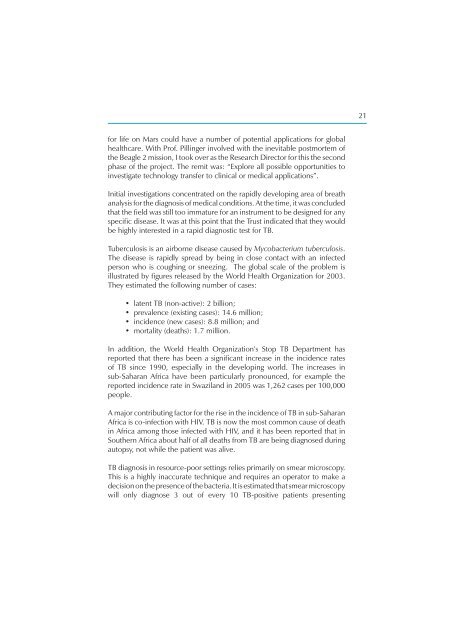Security in Space The Next Generation - UNIDIR
Security in Space The Next Generation - UNIDIR
Security in Space The Next Generation - UNIDIR
You also want an ePaper? Increase the reach of your titles
YUMPU automatically turns print PDFs into web optimized ePapers that Google loves.
for life on Mars could have a number of potential applications for global<br />
healthcare. With Prof. Pill<strong>in</strong>ger <strong>in</strong>volved with the <strong>in</strong>evitable postmortem of<br />
the Beagle 2 mission, I took over as the Research Director for this the second<br />
phase of the project. <strong>The</strong> remit was: “Explore all possible opportunities to<br />
<strong>in</strong>vestigate technology transfer to cl<strong>in</strong>ical or medical applications”.<br />
Initial <strong>in</strong>vestigations concentrated on the rapidly develop<strong>in</strong>g area of breath<br />
analysis for the diagnosis of medical conditions. At the time, it was concluded<br />
that the fi eld was still too immature for an <strong>in</strong>strument to be designed for any<br />
specifi c disease. It was at this po<strong>in</strong>t that the Trust <strong>in</strong>dicated that they would<br />
be highly <strong>in</strong>terested <strong>in</strong> a rapid diagnostic test for TB.<br />
Tuberculosis is an airborne disease caused by Mycobacterium tuberculosis.<br />
<strong>The</strong> disease is rapidly spread by be<strong>in</strong>g <strong>in</strong> close contact with an <strong>in</strong>fected<br />
person who is cough<strong>in</strong>g or sneez<strong>in</strong>g. <strong>The</strong> global scale of the problem is<br />
illustrated by fi gures released by the World Health Organization for 2003.<br />
<strong>The</strong>y estimated the follow<strong>in</strong>g number of cases:<br />
latent TB (non-active): 2 billion;<br />
prevalence (exist<strong>in</strong>g cases) : 14.6 million;<br />
<strong>in</strong>cidence (new cases): 8.8 million; and<br />
mortality (deaths): 1.7 million.<br />
In addition, the World Health Organization’s Stop TB Department has<br />
reported that there has been a signifi cant <strong>in</strong>crease <strong>in</strong> the <strong>in</strong>cidence rates<br />
of TB s<strong>in</strong>ce 1990, especially <strong>in</strong> the develop<strong>in</strong>g world. <strong>The</strong> <strong>in</strong>creases <strong>in</strong><br />
sub-Saharan Africa have been particularly pronounced, for example the<br />
reported <strong>in</strong>cidence rate <strong>in</strong> Swaziland <strong>in</strong> 2005 was 1,262 cases per 100,000<br />
people.<br />
A major contribut<strong>in</strong>g factor for the rise <strong>in</strong> the <strong>in</strong>cidence of TB <strong>in</strong> sub-Saharan<br />
Africa is co-<strong>in</strong>fection with HIV. TB is now the most common cause of death<br />
<strong>in</strong> Africa among those <strong>in</strong>fected with HIV, and it has been reported that <strong>in</strong><br />
Southern Africa about half of all deaths from TB are be<strong>in</strong>g diagnosed dur<strong>in</strong>g<br />
autopsy, not while the patient was alive.<br />
TB diagnosis <strong>in</strong> resource-poor sett<strong>in</strong>gs relies primarily on smear microscopy.<br />
This is a highly <strong>in</strong>accurate technique and requires an operator to make a<br />
decision on the presence of the bacteria. It is estimated that smear microscopy<br />
will only diagnose 3 out of every 10 TB-positive patients present<strong>in</strong>g<br />
21








